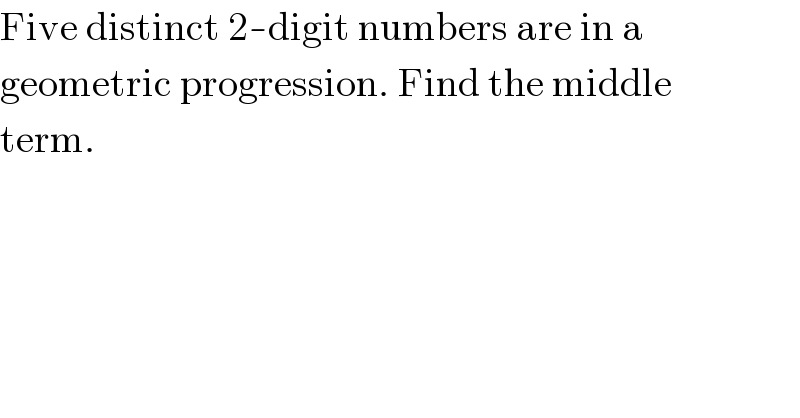
Question Number 20726 by Tinkutara last updated on 01/Sep/17

$$\mathrm{Five}\:\mathrm{distinct}\:\mathrm{2}-\mathrm{digit}\:\mathrm{numbers}\:\mathrm{are}\:\mathrm{in}\:\mathrm{a} \\ $$$$\mathrm{geometric}\:\mathrm{progression}.\:\mathrm{Find}\:\mathrm{the}\:\mathrm{middle} \\ $$$$\mathrm{term}. \\ $$
Answered by dioph last updated on 02/Sep/17

$$\mathrm{Let}\:\mathrm{the}\:\mathrm{GP}\:\mathrm{be}\:\left\{{a},{qa},{q}^{\mathrm{2}} {a},{q}^{\mathrm{3}} {a},{q}^{\mathrm{4}} {a}\right\} \\ $$$$\mathrm{As}\:\mathrm{we}\:\mathrm{are}\:\mathrm{looking}\:\mathrm{for}\:\mathrm{the}\:\mathrm{middle}\:\mathrm{term} \\ $$$$\mathrm{the}\:\mathrm{order}\:\mathrm{is}\:\mathrm{not}\:\mathrm{relevant}\:\mathrm{so}\:\mathrm{we}\:\mathrm{can} \\ $$$$\mathrm{safely}\:\mathrm{assume}\:{q}\:>\:\mathrm{1}. \\ $$$$\mathrm{We}\:\mathrm{know}\:\mathrm{that}\:{a}\:\geqslant\:\mathrm{10}\:\mathrm{and}\:{q}^{\mathrm{4}} {a}\:<\:\mathrm{100}, \\ $$$$\mathrm{so}\:{q}\:<\:\mathrm{2}. \\ $$$$\mathrm{1}\:<\:{q}\:<\:\mathrm{2}\:\Rightarrow\:{q}\:=\:\frac{{m}+{n}}{{n}}\:\left({m}<{n}\:\mathrm{both}\:\mathrm{natural}\:\mathrm{numbers}\right) \\ $$$$\mathrm{Because}\:\mathrm{every}\:\mathrm{term}\:\mathrm{is}\:\mathrm{natural},\:\mathrm{we} \\ $$$$\mathrm{must}\:\mathrm{have}: \\ $$$${n}\:\mid\:{a},\:{n}^{\mathrm{2}} \:\mid\:{a},\:{n}^{\mathrm{3}} \:\mid\:{a}\:\mathrm{and}\:{n}^{\mathrm{4}} \:\mid\:{a} \\ $$$${a}\:<\:\mathrm{100}\:\Rightarrow\:{n}\:\in\:\left\{\mathrm{2},\:\mathrm{3}\right\} \\ $$$$\ast\:{n}\:=\:\mathrm{2}\:\Rightarrow\:{a}\:\in\:\left\{\mathrm{16},\:\mathrm{32},\:\mathrm{64}\right\}\:\mathrm{and}\:{q}\:=\:\frac{\mathrm{3}}{\mathrm{2}}, \\ $$$$\mathrm{but}\:\left(\frac{\mathrm{3}}{\mathrm{2}}\right)^{\mathrm{3}} ×\mathrm{32}\:=\:\mathrm{108}\:>\:\mathrm{100}\:\mathrm{and} \\ $$$$\left(\frac{\mathrm{3}}{\mathrm{2}}\right)^{\mathrm{2}} ×\mathrm{64}\:=\:\mathrm{144}\:>\:\mathrm{100},\:\mathrm{hence} \\ $$$$\mathrm{in}\:\mathrm{this}\:\mathrm{case}\:{a}\:=\:\mathrm{16}. \\ $$$$\ast\:{n}\:=\:\mathrm{3}\:\Rightarrow\:{a}\:=\:\mathrm{81}\:\mathrm{and}\:{q}\:\geqslant\:\frac{\mathrm{4}}{\mathrm{3}},\:\mathrm{but} \\ $$$$\left(\frac{\mathrm{4}}{\mathrm{3}}\right)×\mathrm{81}\:=\:\mathrm{108}\:>\:\mathrm{100}. \\ $$$$\mathrm{Therefore},\:{n}\:=\:\mathrm{2},\:{a}\:=\:\mathrm{16}\:\mathrm{and}\:{q}\:=\:\frac{\mathrm{3}}{\mathrm{2}}, \\ $$$$\mathrm{so}\:\mathrm{GP}\:\mathrm{is}\:\left\{\mathrm{16},\:\mathrm{24},\:\mathrm{36},\:\mathrm{54},\:\mathrm{81}\right\}\:\mathrm{and}\:\mathrm{the} \\ $$$$\mathrm{answer}\:\mathrm{is}\:\mathrm{36} \\ $$
Commented by Tinkutara last updated on 02/Sep/17

$$\mathrm{Thank}\:\mathrm{you}\:\mathrm{very}\:\mathrm{much}\:\mathrm{Sir}! \\ $$
